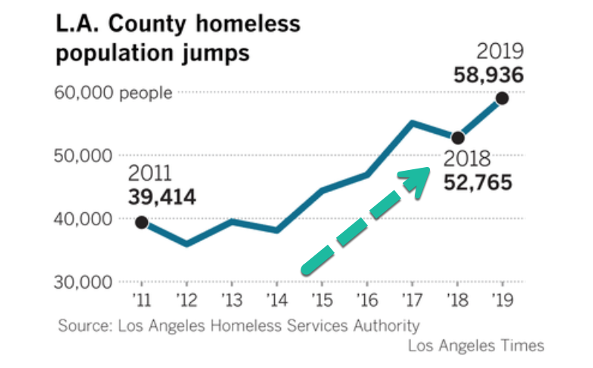CommentsPLANNING WATCH: The many shortcomings of City government in Los Angeles include the inability of City Hall officials to make their cover stories for top-down gentrification programs stick.
Despite their congratulatory back-patting about 150,000 new housing units, most of them expensive apartments near express bus lines and subway stations -- population, employment, homelessness, transit ridership, and climate change trends are all moving in the wrong direction.
There have been a few winners, however. Property owners and developers have hit pay dirt through induced gentrification. They have built these luxury apartments or flipped their recently up-zoned and therefore, more valuable parcels. Nevertheless, the jerry-rigged numbers that City Hall uses to justify its top-down housing programs do not add up.
LA’s population growth is portrayed as a perpetual motion machine, and therefore City Hall claims it must up-zone much of LA to house future Angelenos. Nevertheless, according to the California State Department of Finance, Los Angeles County has lost 40,000 people during the past year, mostly from out-migration. Furthermore, LA’s population decline began long before the Pandemic, and it has accelerated since March 2020, with no turn-around in sight.
Furthermore, the publicly predicted benefits of up-zoning, whether from LA’s two density bonus ordinances, discretionary zoning waivers, or major up-zoning laws, have never appeared – perhaps because existing zoning is so generous. Transit ridership continues to decline, homelessness is increasing, and housing costs have barely moved, despite the building boom and many emptied apartments. As for climate change, it, too, is getting worse, despite new mass transit lines and transit-adjacent housing, both supposed to keep global warming in check.
- Transit ridership continues to shrink, despite the flood of new apartment buildings located near mass transit centers, especially in Downtown Los Angeles, Koreatown, Miracle Mile, and Hollywood. In fact, this adverse outcome reveals that Transit Oriented Developments reduce transit ridership. This should not be a surprise though since only well-off tenants – most of whom rely on cars for personal transportation -- are the only group that can afford high-priced TOD rents.
- Homelessness is steadily rising in Los Angeles, even though new TOD and non-TOD high-rise apartment buildings are popping up everywhere. Nevertheless, despite these new housing units, the number of homeless people has trended upward.

- Despite the construction of 150,000 new apartments, the cost of housing and the number of vacant apartment and parcels has also increased, according to the Vacancy Report: How Los Angeles Leaves Homes Empty and People Unhoused, prepared by the UCLA Law School in cooperation with SAJE (Strategic Actions for a Just Economy). This remarkable study revealed that Los Angeles has 93,500 vacant housing units, including more than 46,400 units used as vacation homes, investments, or are otherwise being held off the market rather than housing people. According to the Vacancy Report, “Los Angeles is building plenty of homes. Unfortunately, much of it is accessible only to the wealthy, with 97% of rental units currently under construction in downtown L.A. classified by the commercial real estate data service Co-Star in the most expensive and luxurious “4 & 5 star” category, in which rents average over $2,800 per month (2017 data).”
- Local housing prices have also steadily grown, despite 150,000 new housing units, higher vacancy rates, and more homeless people. From 2015 to 2020, during the housing boom, the median price of homes in Los Angeles increased from $565,000 to $830,000. Rents have, however, declined by about 7 percent during the Pandemic, usually through teasers of free rent for one or two months. In LA’s suburbs and outlying areas, however, the long-term trends are unchanged. Housing prices have never stopped moving upward.
- Ignored by the planning and budgeting processes, LA’s infrastructure is collapsing despite many billions already spent on mass transit. Plus, METRO will invest $120 billion over the next 40 years on new transit projects. Nevertheless, LA’s non-mass transit infrastructure and public services are failing. LA’s streets and sidewalks have become obstacle courses. The urban forest is dying faster that it can be replanted. Undergrounded utilities fail more quickly than they can be hastily repaired. But don’t worry. If you can hoof it to a future subway station, everything will be alright once you make it underground.
This inventory of trends moving in the wrong direction leads to an obvious question. What are the consequences when the legally required planning process is highjacked to promote short-term real estate speculation? My crystal ball shows the following downside:
Inequality will grow. It is not only increasing because of such Federal policies as tax cuts for the rich, but municipal up-zoning also fosters economic inequality. It hands over instant wealth to property owners, especially those in the up-scale neighborhoods that real estate investors favor, where up-zoning also pulls up rents in surrounding neighborhoods.
Racial and ethnic isolation will also increase in the wake of rising economic inequality. New, expensive housing in homogenous affluent neighborhoods will remain inaccessible as long as wage levels remain low and the cost of housing remains high. The one exception could be the gentrification of poorer neighborhoods (e.g., Boyle Heights) as millennials move into new housing in old ethnic enclaves close to employment centers. The newcomers would displace existing residents, but also “integrate” these established communities.
The quality of life for most Angelinos will decline as trees die, infrastructure and public services fail, and climate change-induced heat waves and wild-fires soar.
Since the numbers clearly do not add up, none of this should be surprising, especially to those charged with planning the future of Los Angeles.
(Dick Platkin is a former Los Angeles city planner who reports on local planning issues for CityWatchLA. He serves on the board of United Neighborhoods for Los Angeles (UN4LA) and is co-chair of the new Greater Fairfax Residents Association. Previous Planning Watch columns are available at the CityWatchLA archives. Please send comments and corrections to [email protected].)
-cw
















